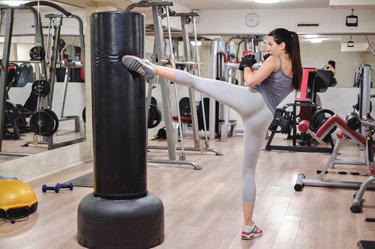
Kickboxing is a fun and highly effective way to get fit. Whether it's practiced in a studio setting or at home as you follow a DVD, kickboxing offers many health benefits.
But, no exercise routine is perfect, and kickboxing isn't an exception. Read this rundown of the positives and negatives of kickboxing to decide if it's right for you.
Video of the Day
Video of the Day
What is Kickboxing?
Typically a kickboxing class is led by an experienced instructor who demonstrates upper and lower body moves like kicks, punches and knee strikes while fast-paced music plays in the background.
Some lower-body kickboxing moves often included in a workout:
- Front kicks
- Knee strikes
- Back kicks
- Side kicks
- Roundhouse
kicks
Upper-body kickboxing moves may include:
- Hook punches
- Jabs
- Uppercuts
Read more: What is kickboxing?
Positives of Kickboxing
Kickboxing workouts are non-contact. All the kicks and punches are directed at the air or cushioned pads. It's also a calorie-burning workout that can work off between 350 and 450 calories per hour, according to the American Council on Exercise. Cardiovascular exercise, like kickboxing, can help you generate a calorie deficit that encourages fat loss.
Kickboxing can also quickly elevate the heart rate into the zone in which cardiovascular conditioning is improved, positively impacting heart health.
Regularly taking kickboxing classes may significantly increase the body's energy levels. Cardiovascular exercise, like kickboxing, helps improve heart and lung function.
Unlike many other forms of exercise, kickboxing utilizes powerful movements. Power is the ability to generate force as fast as possible. Power isn't the same as strength, and for older people, it could be a better predictor of future mobility levels and the risk of falls as they enter their senior years.
Read more: Why is kickboxing a good workout?
Negatives of Kickboxing
As fun and exciting as kickboxing workouts may be, participants also need to be careful because the risk of injury can be somewhat high depending on specific factors.
An older study conducted by researchers at <st1:state w:st="on">Pennsylvania's <st1:place w:st="on"><st1:placename w:st="on">East <st1:placename w:st="on">Stroudsburg <st1:placetype w:st="on">University, that surveyed kickboxing instructors and participants discovered that the rate of reported injuries was high. More than 31 percent of instructors and over 15 percent of class participants reported experiencing a kickboxing-related injury. The causes of these injuries were varied, and ranged from:
- Using improper form
- Excessive speed or intensity
- Class music that was too fast (over 140 beats per minute)
- Excessive
exercise frequency (over four times per week)
A study published in 2015 that looked at the injury rates of people who practiced different types of kickboxing-based martial arts as a contact sport came to a similar conclusion. The study examined records spanning 15 years and over 400 kickboxers and concluded that injuries are both frequent, and often significant, in kickboxing.
On average, kickboxing as a contact sport has an injury rate of roughly 40 for every 1,000 minutes of time played, resulting in approximately 2.5 injuries per hour. This makes contact kickboxing about as dangerous as the different karate styles and is more than the typical injury rate of about one every hour for mixed martial arts, western-style boxing, tae-kwon-do or even judo.
Kickboxing classes may also have a steep learning curve for some people. If someone has trouble learning combinations of movements in a class environment, kickboxing might not be for them. Kickboxing classes are also more regimented than other forms of exercise that are more self-directed, like running, biking, or swimming. People who don't enjoy being led by an instructor in a class with others may not enjoy this form of exercise very much.
- Muscles Ligaments Tendons Journal:The effects of five weeks of kickboxing training on physical fitness: Ibrahim Ouergui,Nizar Hssin,Monoem Haddad,Johnny Padulo, Emerson Franchini,Nabil Gmada,Ezzedine Bouhlel: (2014)
- The Journal of Strength & Conditioning Research:Incidence of Injury in Kickboxing Participation:ROMAINE LINDA J:(2003)
- Orthopaedic Journal of Sports Medicine:Injuries to Professional and Amateur Kickboxing Contestants A 15-Year Retrospective Cohort Study:Reidar P. Lystad:(2015)

